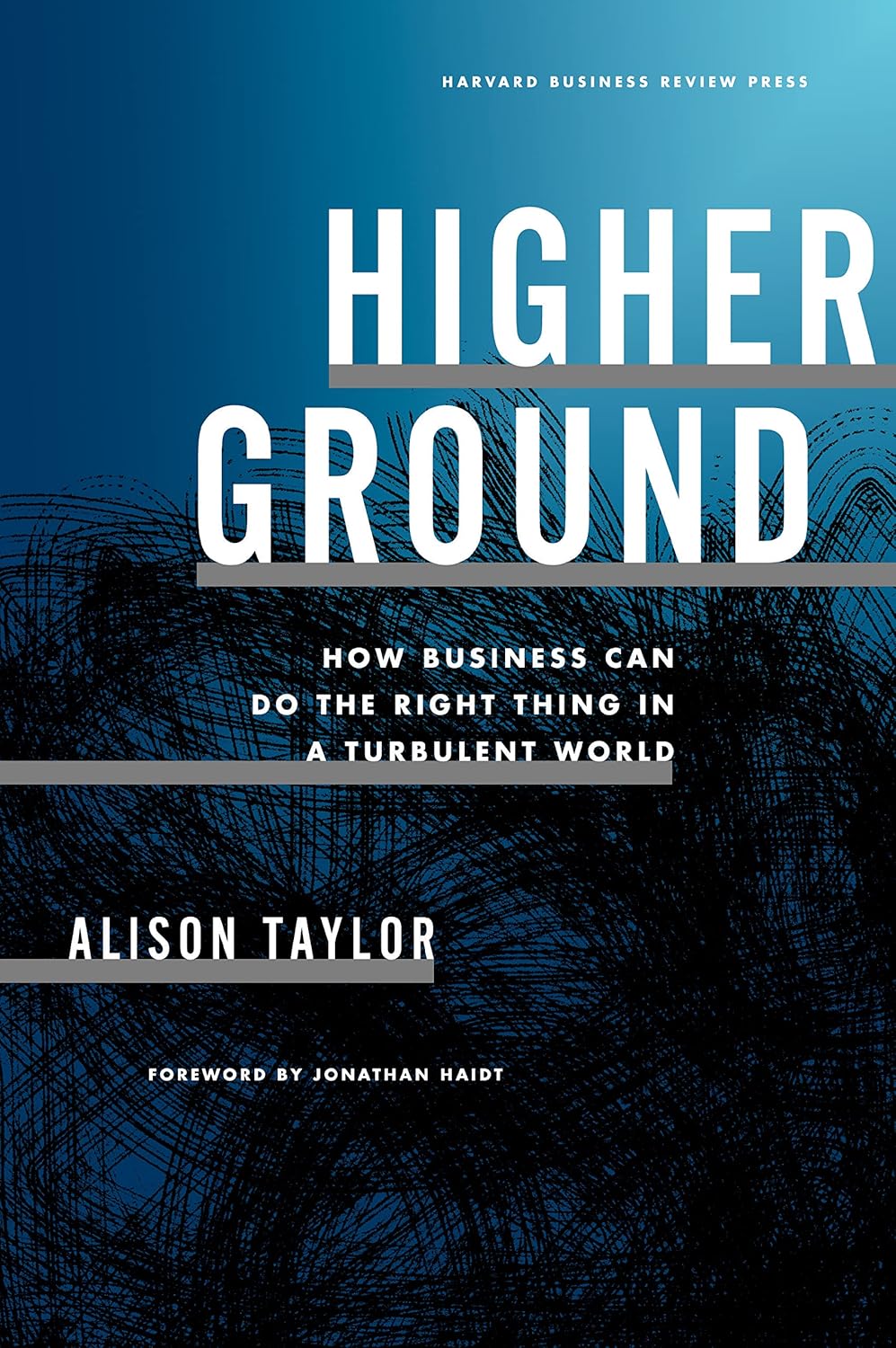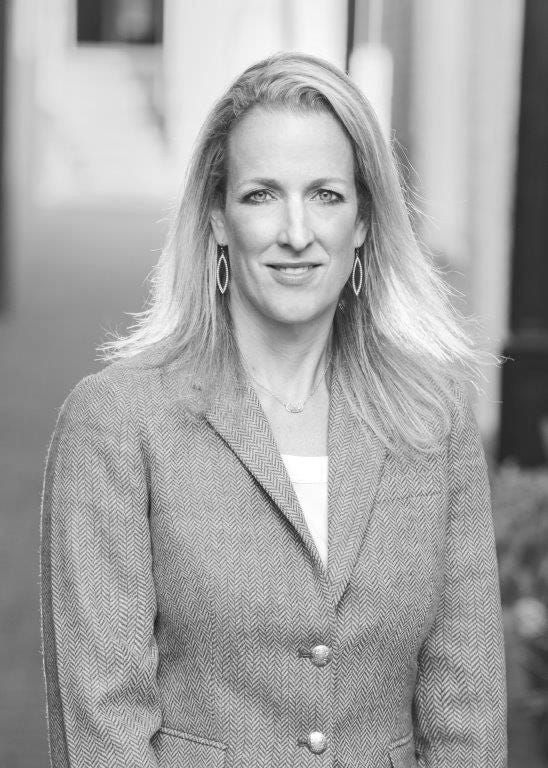
Alison Taylor, in her new book Higher Ground: How Business Can Do the Right Thing in a Turbulent World, offers practical advice to business owners and executives on how to navigate the choppy waters of business leadership in the 21st century, which includes trying to please everyone from customers, vendors, shareholders, activists, regulators, policymakers, and employees, to anyone with an influential social media account. It is an exhausting and impossible task that creates distractions and pulls executives in unobtainable directions. Taylor is a clinical professor at the NYU Stern School and has years of experience consulting large multinational corporations on matters such as organizational risk, corruption, and navigating the strange business world that we find ourselves in today, which she rightly describes as turbulent.
The book is divided into three parts. Part I begins with an explanation of why everything became so chaotic and complicated. Part II offers advice on how businesses can do the right thing, which includes dealing with building stakeholder trust, tackling corruption, understanding the human element, dealing with transparency without worsening the situation, and tackling corporate political responsibility. Part III provides advice on corporate leadership into the future. Taylor argues this requires a more curious and dynamic corporate culture that eschews top-down control and values ethical leadership in the C-suite, which has appropriate checks and balances.
Long gone are the days when you were on a first-name basis with the local hardware store owner. We live in a world of trillion-dollar companies that create vast social and material value; however, both large and small companies are increasingly pulled in contradictory and chaotic directions. A company that attempts to serve everyone will likely fail in fulfilling its most important mission: serving its customers. This is where many will take issue with the author.
She wastes no time disputing Milton Friedman’s claim that the social responsibility of business is to maximize profit within the boundaries of the law. This comes from both Capitalism and Freedom and his famous 1970 New York Times essay where he argues:
‘The short‐sightedness is also exemplified in speeches by businessmen on social responsibility. This may gain them kudos in the short run. But it helps to strengthen the already too prevalent view that the pursuit of profits is wicked and immoral and must be curbed and controlled by external forces. Once this view is adopted, the external forces that curb the market will not be the social consciences, however highly developed, of the pontificating executives; it will be the iron fist of Government bureaucrats. Here, as with price and wage controls, businessmen seem to me to reveal a suicidal impulse.’
Ironically, in 1970, Milton Friedman predicted the chaotic environment in which corporations find themselves today. Most of the anecdotes Taylor documents throughout the book are occurring because we did not heed Milton Friedman’s advice.
Taylor is correct that businesses are pulled in too many directions and cannot possibly be all things to all people. The Coasian theory of the firm is not dead—the firm has boundaries regarding what it can accomplish based on transactions costs. Yet, throughout the book, a tension remains regarding what the author would like corporations to accomplish and the clear absurdity of what firms face today from every angle. She is correct when she argues that focusing on human beings, fostering a corporate culture of respect with open feedback loops, thwarting corruption, and overcoming executive blind spots are immensely important.
We live in a social media-driven world, where a single corporate email can become a viral TikTok trend that takes down a company. Taylor is correct that corporate culture and leadership must be priorities for businesses, as one business alone cannot solve all political issues within its industry, and it should not use legal and regulatory rules to serve its interests. Taylor affirms this, yet, firms distort and manipulate the legal rules of the game all the time.
Taylor is not an economist, and as such, this book is unable to address some of the very problems it seeks to confront. It begs for public choice analysis. In the introduction, she reasonably claims that business has become increasingly political, which causes internal conflict and problems. She later dedicates a chapter to navigating the political process more effectively. Taylor suggests that companies may need to argue for ‘shrewd regulations which level the playing field.’ Still, this almost always creates snowballing regulations, which are socially costly and distract businesses from serving their customers. Taylor appears to understand the threat of cronyism, citing research that demonstrates a negative relationship between corporate political investment and market valuation (page 131), but understates its pathologies, believing that companies can remain neutral while engaging in political matters.
We must always count the costs and be aware of potential unintended consequences. One is the formation of the Iron Triangle, where special interest groups, bureaucrats, and policymakers align in such a way that outsiders cannot assert any influence or change those symbiotic and preferential relationships. Moreover, the author makes assumptions about which political and corporate matters are essential based on her more progressive worldview.
She assumes measures to address climate change are valuable, that ESG has been maligned as an ‘ideological, “socialist” movement,’ that environmental and social responsibility ‘is always good for the bottom line,’ and that healthcare is a human right. Yet, there is wild disagreement on these claims. Taylor understands that when a firm chooses a side on any of these issues, some backlash is inevitable. Yet her point of view argues that these progressive causes are worthy, but that Republicans and conservatives try to block them at every turn, and she seems somewhat critical of capitalism itself. These vantage points are the basis for her somewhat technocratic approach to using regulations productively. The economic way of thinking, if employed, would force her to put these assumptions to the test of cost-benefit analysis.
Taylor (page 30) invokes the controversial Larry Fink, CEO of BlackRock, who has made the social and political case that business must ‘show how it makes a positive contribution to society.’ Taylor implies Republicans have unfairly targeted Fink, yet some would argue that he is imposing a social agenda outside the rule of law and has created vast personal wealth in the process. This appears to be cronyism on full display. Taylor points to the Boeing 737 Max scandal as an example of why Friedman was wrong, because maximizing shareholder value might lead one to defend corporate political spending to reduce regulatory burdens. Taylor implies that avoiding this crisis requires either more or better regulations. This, however, is actually a problem of incentives. If Boeing has captured the regulators who are charged with ensuring its operation is safe, then, rather than advocating for more or better constructed regulations, the only corrective is to disentangle these political and corporate interests.
Yet, Friedman argued that we should get back to the basics. Firms do their best when they make a profit and operate within the rules of the game. This is not to suggest that we do not face real problems in the world. Environmental concerns are real and require creative solutions. Human rights issues abound around the globe, and firms must ensure they are acting with integrity, as corruption can be a powerful intoxicant.
This book wrestles with real problems. Yet Friedman is vindicated even though Taylor thinks his argument is no longer enough. Taylor (page 134) succinctly characterizes the pressures businesses face today: ‘We’ve all begun to expect action on the issues of the day from brands we patronize. We cannot possibly keep track of all the issues and corporate stances, let alone consistently and effectively reward or punish companies via our spending or in statements we post on social media. This illusory process has lured us down a side trail of unrealistic expectations. It redirects valuable energy that’s needed to run businesses and responsibly manage operational impacts. It distracts the public from pursuing healthy political endeavors.’ There is much to agree with in this statement, but doesn’t it vindicate Friedman’s warning?
Business exists to serve the demands of consumers, and consumers are fickle. They always want things faster, better, and cheaper. The goal of a firm is to serve its customers and uphold the rule of law. The more firms diverge from this and try to wade into political and regulatory battles, the more they invite the government into their business, causing them to lose sight of value creation and distorting their incentives to create social value.
Firms operate through property rights, profits and losses, and prices, but government intervention distorts these signals and incentives. Economists agree that firms should be free to advocate for any issues they care about, yet this freedom often leads to disagreement, as Taylor points out. Lines will be drawn in the sand, so maybe companies should talk less and innovate more. This book addresses timely, complex, and important matters of corporate governance. Taylor offers sound practical advice when it comes to remembering that one firm cannot do everything, that political battles are divisive, and that we must focus on a humane corporate culture. Perhaps returning to the basics is the best way to navigate complex and multinational corporations in this digitized and globalized world.
‘Higher Ground: How Business Can Do the Right Thing in a Turbulent World’ by Alison Taylor was published in 2024 by Harvard Business School Publishing (978-1-64-782343-6). 304pp.

Anne R. Bradley is the Vice President of Academic Affairs at the Fund for American Studies. She is a professor of economics at the Institute of World Politics and an affiliate scholar at the Acton Institute.